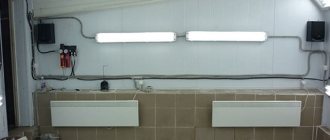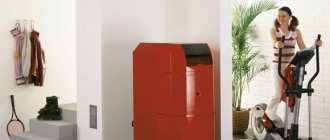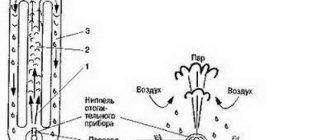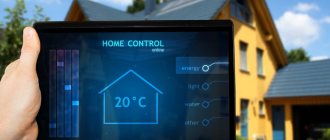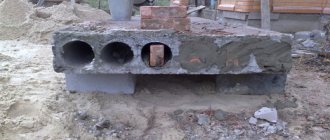Ways to use solar energy
Technologies using solar energy seem new only when compared to more traditional systems. Solar heat has long been actively processed into thermal and electrical energy, especially in those countries where the Sun shines all year round. In northern countries, this is more difficult, but even in this case, solar energy has applications, because it can be used as a backup energy resource.
Two types of devices are used to collect solar energy:
- Solar panels . These devices store the collected energy and allow it to be used to power electrical appliances. Solar panels are panels with photocells installed on the front side and a locking mechanism on the other side. A solar battery for heating a house is not very complex in design, so such elements are sometimes assembled independently, but it is much easier and more reliable to buy ready-made devices.
- Solar collectors . This type of device is designed to be included in a heating system. Such structures are heat-insulated boxes in which the coolant passes. Collectors are installed on the roof or special panels on the side of the building that receives the most sunlight. To make energy absorption more efficient, the systems are made to rotate in accordance with the direction of the sun's rays.
The difference between collectors and solar panels is clear from their design. Collectors (solar systems) are used directly to heat the coolant, while batteries collect energy to convert it into electricity. Of course, solar panels can also be used to heat a house, but such a scheme is quite inconvenient and is also demanding on weather conditions - for normal heating there must be at least 200 sunny days a year.
Advantages of a solar heating system
There are several advantages of solar panels for home heating:
- All year round your home is provided with the necessary heat. You can also adjust the temperature in the house at your discretion.
- Total independence from housing and communal services. Now you don't have to pay huge heating bills.
- Solar energy is a reserve that can be used for various household needs.
- These batteries have a very good service life. They rarely fail, so you won't have to worry about having to repair or replace some components.
There are some nuances that you should pay attention to before choosing this system. After all, such a system may not be suitable for everyone.
In many ways, the quality of such a heating system depends on the geography of residence. If you live in a region where the sun does not shine every day, then such systems will be ineffective. Another disadvantage of this system is that solar panels are expensive. However, we should not forget that such a system will completely pay for itself over time.
Duration of sunshine in Russia
In order to supply the house with the necessary amount of heat, you will need from 15 to 20 square meters. meters of solar panel area. One square meter produces an average of up to 120W.
In order to receive about 500 kW of heat per month, it is necessary that there are about 20 sunny days per month.
A prerequisite is to install solar panels on the south side of the roof, since it receives the most heat. In order for solar heating to be as efficient as possible, the roof angle should be about 45 degrees. It is advisable that there are no tall trees near the house or other objects that can create shadows. The rafter system of the house must have the necessary strength and reliability. Since solar panels are not entirely lightweight, care must be taken to ensure that they do not damage the building or provoke destructive processes. The likelihood of collapse increases in winter, since at this time snow will accumulate on the roof, in addition to heavy batteries.
Solar panels are usually placed on the roof of a house
Despite the fact that solar panels are quite expensive, they are increasingly gaining popularity. They are used even where the climate is not too hot. This system can also be used as additional heating at home. Such systems are most effective in the summer months, when the sun shines almost every day. However, do not forget that the house must be heated mainly in the winter months.
Advantages and disadvantages of solar heating
The advantages of solar heating systems include the following qualities:
- Environmental friendliness . The absorption and transformation of solar energy occurs without any emissions of harmful substances, so we can talk about the complete environmental friendliness of such systems.
- Autonomy . Solar heat is completely free, which allows you not to think about the current level of energy prices and the need to supply them to your private home.
- Economical . Combining traditional and alternative heating allows you to save a lot of money during operation. If you use only solar heating, then all costs come down to purchasing the necessary system elements and their maintenance.
- Availability . Solar collectors and batteries do not need to be approved by any government agencies, since the operation of such systems is autonomous and does not pose any danger.
Among the shortcomings, the following qualities mainly stand out:
- Long period for determining effectiveness . To understand how effective and profitable a solar system is under specific operating conditions, it needs to operate for at least 3 years.
- High cost of equipment . Solar batteries and their components are quite expensive today, so it will not be possible to do without significant initial investments.
- Dependence on external conditions . If the climate in the geographic location where the collectors are installed does not have many sunny days, then installing solar devices may not even be practical.
- The need for backup heating . In order for the heating system to be reliable, it must be duplicated (the backup circuit is usually solar heating).
- Requirement for maintenance . Solar collectors need to be properly maintained, constantly carrying out preventive and cleaning work. Starting the system at subzero temperatures is only possible if it and the house itself have reliable protection from the cold.
If the advantages of solar equipment seem too important, and the disadvantages are not critical, then the devices in question are ideal for providing the home with electricity and heat.
Solar panels for heating
The use of solar panels for arranging a heating system has a number of nuances. The thing is that such devices are mainly designed to collect energy, which is subsequently converted into electrical energy. To make heating using solar panels, you will need to assemble a system connected to a storage tank - it is in this structural element that the coolant will be heated.
To understand whether it is possible to profitably use solar panels to heat a house in winter, you need to consider the types of these devices, their operational features and methods of use.
Solar collectors
Solar collectors are used for solar heating. These installations use the heat of the sun to heat the coolant fluid, which can then be used in a water heating system. The specificity is that a solar water heater for heating a house produces only a temperature of 45-60°C, and shows the highest efficiency at an output of 35°C. Therefore, such systems are recommended for use in conjunction with warm water floors. If you don’t want to give up radiators, either increase the number of sections (approximately twice as much) or heat up the coolant.
To provide the house with warm water and for water heating, you can use solar collectors (flat and tubular)
Now about the types of solar collectors. Structurally there are two modifications:
- flat;
- tubular.
In each of the groups there are variations in both materials and design, but they have the same operating principle: a coolant runs through the tubes, which is heated by the sun. But the designs are completely different.
Types and design of solar panels
There are three main types of solar panels:
- Monocrystalline . The working element of such devices are thin wafers made of pure silicon grown artificially. The efficiency of such plates in the best case reaches 17-18%. The most comfortable operating temperature is from 5 to 25 degrees.
- Polycrystalline . The working element is wafers, which are obtained as a result of gradual cooling of molten silicon. This manufacturing method is simpler than the previous one, but the efficiency is also appropriate - at best it reaches 12%.
- Amorphous (film) . To produce such batteries, silicon is evaporated and deposited into a thin film on a polymer base. The low cost of production and ease of manufacturing of such devices has a direct relationship with efficiency - the efficiency of amorphous batteries does not exceed 7%.
In countries with predominantly cold climates, solar panels made using monocrystalline working cells are most often used. However, the choice of the most suitable type cannot be called obvious - film modules are much more convenient to install, do not impose special requirements on the base and are much cheaper.
External battery elements are designed to collect and convert solar energy, which will later be transferred to the storage device. Small individual batteries generate about 100-250 W of energy, and prefabricated modular structures with an area of 25-30 m2 can provide electricity to a small residential building. To use solar panels to heat a house, their area must be several times higher than the specified value.
An inverter is used to convert the sun's rays into electricity. The need to install it is due to the fact that electrical appliances use only alternating current. The same rule applies to electric heating equipment. In order for the system to provide the house with energy around the clock, it must be supplemented with batteries that allow it to store electricity.
Efficiency
To use solar energy to heat a private home, it will be much easier to assemble a circuit from collectors - but this is not always possible, so you have to consider other options. For example, it may well be that a working system of solar panels is already installed on the site, which is used only to provide the house with electricity and hot water.
Purchasing new equipment under such conditions will be too unprofitable due to its high cost. To ensure heating of the house with solar panels, the optimal solution would be to increase the power of the module system. The easiest option is to purchase several additional silicon panels and connect them to the heating boiler system, powered by electricity.
Proper distribution of electrical energy will provide both a hot water supply system and a heating circuit. To have enough power for everything, you will need a lot of solar panels - off-grid buildings that use only solar energy are usually completely covered in photovoltaic panels. The power of solar panels must be calculated in advance. Often it is necessary to complete the construction of an additional structure on which the panels will be installed.
It is not possible to determine the efficiency of a solar system before using it, so all calculations are only approximate. The complexity of preliminary calculations is due to the fact that there are a lot of factors whose influence on the efficiency of energy collection is impossible to calculate. Of course, if you have some experience, you can make a more or less accurate calculation, but only professionals who specialize in the design and installation of solar systems have such experience.
The following factors have the greatest influence on the efficiency of the system:
- Weather instability - it is impossible to determine in advance the number of sunny days even in sunny regions, not to mention the northern regions;
- Unstable energy consumption, which also depends on the geographical location of the building, which receives heat and electrical energy from sunlight;
- Possibility of system failure - the complexity of the design indicates that it will often break down, and in some cases it can be difficult to determine the failure.
You can only know how efficient solar panels are after they have been in use for some time. Based on the results of the analysis of the system operation, it will be possible to decide whether there is a need to install additional photocells or batteries. In addition, it is also worth assessing several additional parameters - for example, if heat loss is too high, then the operation of the system can be optimized by improving the thermal insulation of the entire house.
Design and principle of operation
Solar heating of a private home is an innovative technology that not everyone has a clear understanding of yet. Meanwhile, almost any homeowner has all the possibilities for installing and using the appropriate complexes. The need for financial investments exists only to purchase equipment or equipment; he will receive everything else for free.
There are two options for organizing solar heating:
- Solar panels;
- Solar collectors.
Using solar panels is a more expensive method that requires a large amount of equipment. Photovoltaic elements are used, located in an open area at the desired angle for maximum perpendicular incidence of sunlight. They generate electric current, which is accumulated in batteries, converted into alternating current with standard parameters, and then sent to heating devices.
Heating from solar panels in a private home provides a lot of additional opportunities. This method has a significant advantage - the electric current generated by solar panels can be used not only to heat the house, but also to power any devices, for lighting or other needs.
Solar panels for home heating, the cost of which is quite high, may not be financially viable.
Solar collectors operate on a different principle. They do not produce, but receive thermal energy from the Sun, which heats the coolant in containers or tubes. In principle, any container of water exposed to the sun can be considered a collector, but there are special designs that can demonstrate the greatest efficiency. This version of the system is much simpler, cheaper and available for self-production.
The resulting heat is immediately realized in increasing the temperature of the coolant, which is accumulated in a storage tank, from where it is distributed throughout the heating circuits of the house. The optimal heating method is to use low-temperature systems such as underfloor heating. They do not require strong heating, which corresponds to the capabilities of solar collectors. At night, the coolant heated during the day is consumed.
For maximum efficiency of solar collectors, it is necessary to properly insulate the storage tank.
Installation of a home solar power plant
The simplest solution that immediately comes to mind is to contact a company that specializes in the sale and installation of solar generators. This solution has a lot of advantages - specialists will be able to prepare an individual project that is most suitable for specific operating conditions, and a guarantee will be issued for the purchased and installed equipment. The disadvantage of this solution is that the cost of the work is too high.
However, you can assemble a home solar power station yourself, but this will require considerable experience, as well as a significant investment of labor and time. In addition, you will need to understand what elements are needed to set up the system and how they interact with each other.
The set of elements for installing solar heating is as follows:
- Set of solar modules;
- Accumulator battery;
- Charge controller;
- Inverter;
- Switching.
It is advisable to select batteries so that they have the same characteristics. Good batteries can hold energy for about 3-4 days, and this parameter also needs to be taken into account, as well as the fact that devices discharge much faster in a cold room. For a daily consumption of 2400 Wh, the total battery capacity must be at least 1000 Ah.
Inverters used for solar systems have the ability to synchronize the voltage phase, as a result of which the conversion of 12 V to 220 V is carried out without the slightest delay, so electrical appliances do not experience unnecessary loads. Centralized power grids cannot boast of such quality, so solar generators in this regard are much more convenient and reliable.
After installing each element of a solar-powered system, you need to complete the work. To do this, you need to connect an electric storage device to the system, in which the water will be heated from the sun. The storage device is subsequently connected to the heating circuit of the building, thereby ensuring its heating - for example, it is quite possible to power a heated floor from a solar battery of sufficient power.
Collector heating at home
Of course, it is possible to assemble a heating system using solar batteries, but it is much more convenient and practical to use elements originally intended for heating - solar collectors. Such devices provide direct water heating using solar energy, and there are no intermediaries in this chain.
There are two types of collector structures:
- Flat;
- Tubular.
Each system needs to be examined in more detail in order to be able to consciously choose the most suitable option for a particular situation.
Variety of installations
Before you start creating a solar heating system for your dacha and home with your own hands, you need to find out what kind of batteries even exist. Today's solar collectors come in the following types:
- vacuum. In the design of such a battery, there is a vacuum between the shell of the unit and the heating body. With this device you can heat water up to 300 degrees. The downside here is the inability to independently clean snow and frost;
Vacuum manifold
- flat. Externally, such a collector looks like a transparent outer panel. This type of solar cell has tubes inside it, and the back is equipped with a thermal insulator. There is more heat loss here, but the structure is easy to assemble with your own hands. In addition, you can clean it yourself from frozen snow and ice. Heats water up to 200 oC. The disadvantages include the presence of a large load on the device’s clamps in strong winds, since the battery has a poorly streamlined shape;
Flat-plate collector
- air. Air acts as a heat carrier here. Such batteries can easily be made with your own hands. But the main disadvantage here is the inability to use the device to heat water, as well as the low efficiency of the device;
Air manifold
- tubular. A unit of this type consists of four tubes filled with a base coolant. Its circulation is carried out due to the temperature difference between the battery and its lower zone. Such devices are characterized by a large surface plane;
Tubular manifold
- a mobile system used to heat a house with solar energy. These are specially designed installations that can rotate according to the movement of the sun. Today, there are various models capable of rotating their various parts.
Movable solar panels
Despite the different structure, the operating principle of solar collectors will be almost identical.
Flat-plate collector installation
Structurally, flat solar radiators for heating a house are extremely simple. In some cases, such systems are partially assembled by experienced craftsmen from scrap materials. Of course, it is very difficult to completely do without ready-made elements, but even small savings with the proper experience can be justified.
The flat-plate collector device is an insulated metal box containing a plate that absorbs solar energy (most often hidden under a layer of black chrome). From above, this part of the structure is covered with a sealed transparent lid. The water is heated in tubes that are arranged like a snake and connected to the plate.
You can connect collector heating using either a single-pipe or a two-pipe scheme - there are no significant differences in the operation of both schemes. Much more important is the method of circulation of the coolant. Gravity systems are considered unprofitable due to the low speed of water movement along the circuit. Forced circulation, which is provided by a pump, is more efficient, so it is used in the vast majority of systems.
Tubular manifold installation
According to the principle of operation, tubular solar thermal panels are similar to their flat counterparts, but there is one noticeable difference - tubes filled with coolant are located inside glass flasks. The system can use feather tubes, closed on one side, and coaxial tubes, which are inserted into each other and sealed on both sides.
It is also worth noting the types of heat exchangers used:
- System for converting solar energy into thermal energy Heat-pipe;
- Standard tubes for moving water U-type.
The second type of heat exchanger is considered more efficient, but it has a serious drawback - the high cost of repairs, which is due to the need to replace the entire unit if one tube is damaged. With tubes of the first type it is much simpler in this regard, since they are independent of each other, which allows, if necessary, to replace each individual structural element.
Summarizing the consideration of flat-plate and tubular collectors, we can draw the following conclusions: in warm regions, flat-plate collectors are much more profitable, and for the northern regions it is better to select tubular devices. In harsh climates, Heat-pipe systems work best, and perform well even with minimal lighting.
What to pay attention to
When choosing a solar collector, in addition to the criteria given above, you need to pay attention to a number of points, taking into account which you can avoid inconvenience during further operation of the device.
It should be remembered that:
- Flat-type models are more durable, but not easy to use. To repair them, it is necessary to stop the entire heating system, and in the absence of shut-off valves at the inlet and outlet of the collector, the entire amount of coolant must be drained.
- Models using vacuum tubes are more repairable, but less durable. If it is necessary to replace tubes (one or more), they are replaced without stopping the heating system.
- Flat-plate collectors are able to heat the coolant more than vacuum devices, which makes them more efficient when used in winter.
- Air collectors are reliable and durable, but due to their technical characteristics, they are not capable of fully heating large construction volumes.
- The collector's passport indicates its rated power, i.e. the ability to convert solar energy into thermal energy at the moment of maximum solar activity (noon) and in clear weather.
- The correct location of the device in space, in relation to the surface of the earth, will avoid difficulties during operation.
- Before deciding to purchase a specific model, it is necessary to develop a solar installation diagram, calculate its power and possible heat losses.
Increasing the efficiency of solar modules
The efficiency of solar systems can be increased by using one of the following methods:
- Changing the location of modules . Sometimes, to increase efficiency, it will be enough to correctly position the modules relative to the directivity vector of the sun's rays. Typically, this requires turning all modules to the south. If the day in the region is long, you can also use surfaces facing the east and west - there is also enough light there, which is converted into energy.
- Changing the angle of inclination . The documentation for the modules always indicates the recommended tilt angle at which the system efficiency will be maximum. In practice, this value may vary significantly depending on geographic location and other individual characteristics.
- Choosing a location for installation . Most often, solar modules are installed on the roof of a building - this is the simplest, most affordable and obvious option, but not the most effective. It is best to prepare a rotating base in advance and install panels on it so that the devices follow the sun's rays as they move.
The last point deserves special attention. Of course, roof-mounted modules are not useless - after all, in this case there are no obstacles to the sun's rays, so they easily reach the device and are converted into the necessary type of energy. The problem is that placing the modules perpendicular to the sun's rays has maximum efficiency over a short period of time.
Rotating devices that track the current direction of the rays eliminate such problems. True, such devices also have negative sides - in particular, we are talking about the extremely high cost of rotary systems. In addition, in some cases, the purchase of such equipment does not in any way affect the efficiency of the system - for example, if climatic conditions have not been properly taken into account. The costs in this case will be completely unreasonable.
According to approximate calculations, in order for the rotary elements to pay off, their number must be at least eight. Of course, you can use a smaller number of modules (about 3-4), but they will be a profitable purchase only if you connect them directly to the water pump; in other cases, the increase in efficiency will be insignificant.
Today, the development of a completely new type of roof, in which solar panels are installed initially, is actively underway. According to the manufacturers, such a roof will cost significantly less than conventional roofs on which solar equipment is installed, and will be at least as effective.

